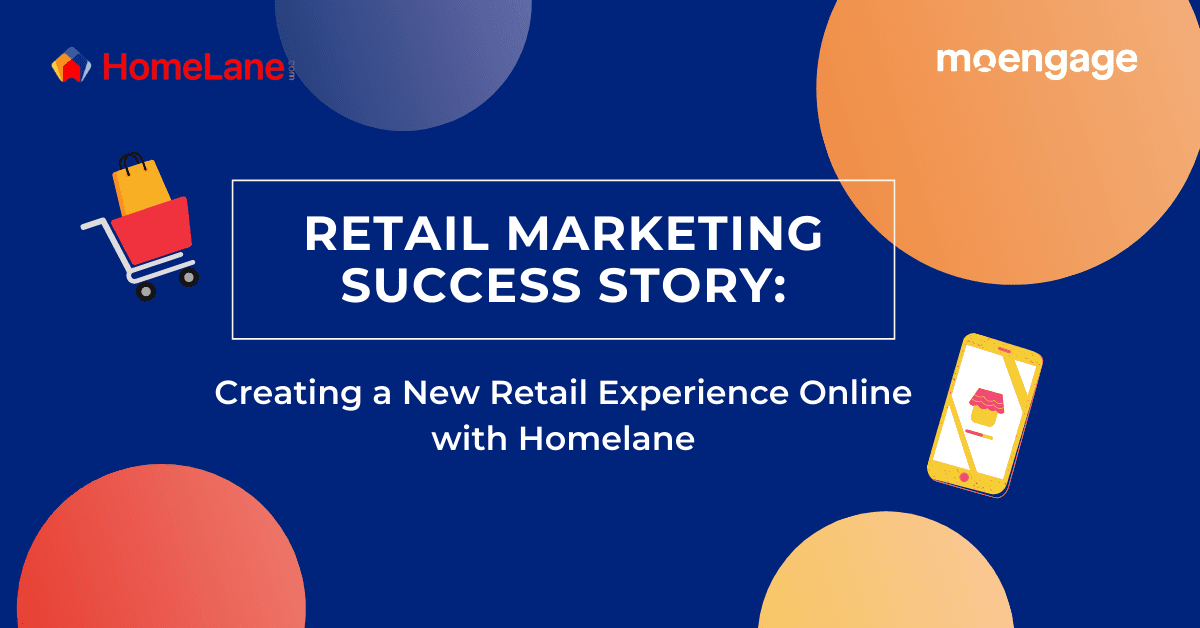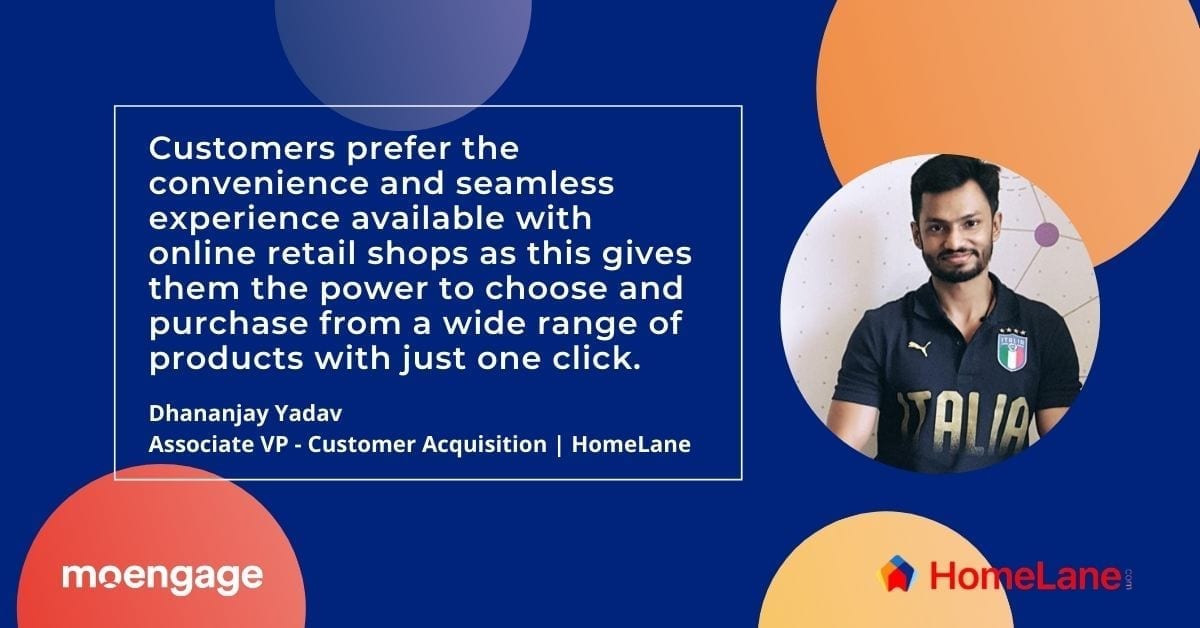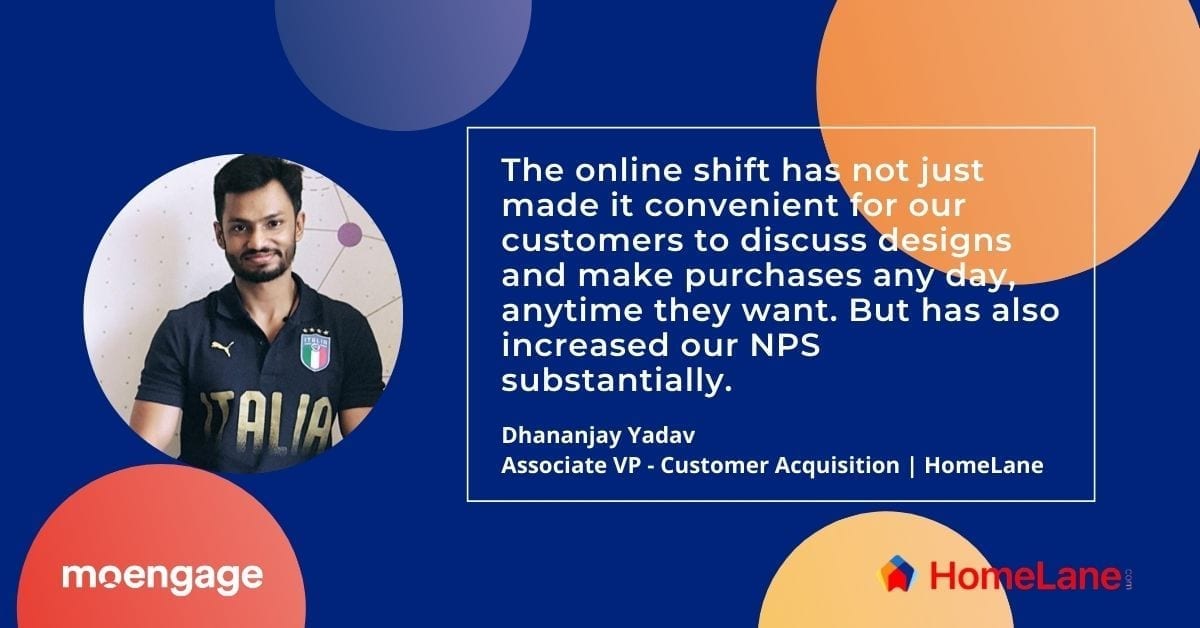How HomeLane Creates a New Online Retail Marketing Experience

Reading Time: 5 minutes
In recent years, online retail shopping has started to gain prominence among shoppers. According to a report, over 2.05 billion people are expected to shop online this year. Statista predicts that by the end of this year, e-commerce sales would have reached $4.2 trillion. They predict it to hit $6.5 trillion by 2023. In fact, the popularity of online shopping has become so strong that research shows that US department stores for apparel may hit the end of the road soon. This has led to retail marketers thinking of new ways to create an online retail marketing experience for shoppers.
I got the opportunity to talk to one such customer acquisition leader who understands customer’s pulse. He’s implemented offline to online transition strategies to better serve the customers. Please meet Dhanajay Yadav, Associate Vice President for Customer Acquisition who’s worn multiple hats across customer and marketing functions for verticals such as retail and ed-tech.
| Bonus Content
👉 Customer Lifecycle Marketing Campaigns: An In-depth Guide for 2021 [Download Ebook] 👉 Beginner’s Guide to Omnichannel Marketing for 2021 [Download Ebook] |
How brick to click shopping is shaping up a new online retail marketing experience?
The transition from offline to online shopping has led to some new retail experiences, such as:
- More focus on omnichannel presence: Now shoppers can use multiple devices and channels to shop instead of going all the way to the shop or relying on a website alone. Shoppers can shop using a laptop or a mobile phone. They can shop from the multiple options website, social media page, or an app for convenient shopping.
- Better personalization: The use of advanced data analytics has enabled retail marketers to personalize the experience of shoppers through targeted communication. 91% of customers have stated that they are likely to shop with brands that offer them relevant offers and recommendations.
- More convenience: From offering personalized discounts to offering flexibility in payment options, online shopping provides more convenience and a better experience to customers.
The need for online presence started to become clear when the pandemic shook the entire world early this year.

What’s the impact of the pandemic on retail shopping behavior?
The brick and mortar shops were forced to stay shut to curtail the spread of COVID-19. Even customers were unwilling to step out of their homes to buy daily needs products. The online sales increased so much that the orders for groceries on Amazon had spiked up 50 times.
Although malls and other shops have started to reopen after almost six months, there seems to have been a drastic shift in customer behavior.
Customers prefer the convenience and seamless experience available with online retail shops and might prefer to continue shopping online in the future too. This has given them the power to choose and purchase from a wide range of products with just one click.
If you have not shifted your presence online, then it’s time to take notice of this change and pivot quickly to remain relevant and to offer a new online retail marketing experience to the customers.
It is perhaps the only way to retain customers in today’s time.
How is customer behavior in the high-ticket home décor industry?
Although fashion apparel and grocery have already made a mark in the online space, the home décor industry is still at a very nascent stage. 80% to 85% of our business meetings took place offline. The only digital interaction was when the customer visits our website to fill the lead form. After that, our designer would get in touch with the customer, ask for a floor plan, and invite them to visit our nearby showroom for a detailed discussion. Our customers preferred it too because finalizing a home décor for your dream home is a long-term plan, and it would ideally require five lakhs to ten lakhs worth of investment.
Online interactions did not seem fit for both customers and us. Offline meetings worked well for us. It helped us to build a trustworthy relationship with the customers. It enabled them to get an overall idea of the design and book purchase from us. These purchases could be anything from modular kitchens to wardrobes. Only 5% to 10% of our leads would prefer a digital interaction. Most of them used it as a means to evaluate options before finalizing a designer. We considered them low-intent customers. Our observation was that only serious buyers took the efforts to visit the showroom.

Why HomeLane transitioned to online shopping and how it helped their business?
Although we were aware of how crucial digital presence is for our business, we truly started to introspect about it a little before the lockdown was announced. We realized that although offline experience helps in building trust, convenience also matters. Our target customers are busy working professionals. They could visit our showroom only during weekends as weekdays were busy days for them. We realized that by digitizing our showrooms, people could book meetings with designers even on weekdays and get the discussion started immediately. Luckily we pivoted our business a week before the lockdown was announced.
Here are a few things HomeLane changed about their online retail marketing:
- The first thing we did was ensure a seamless experience for our customers. We ensured that our digital showrooms were functioning properly.
- When showrooms opened, we allowed only 30% capacity at a time. We also observed proper precautionary measures within the showroom.
- We secured that the visits were well-planned and only conducted after all the preliminary discussions were done digitally. Earlier, our designers would receive a floor plan from the customer; the designer would go through it and give a detailed walkthrough of the décor they planned. The entire process required multiple showroom visits. Now the process has changed completely. Now the customer has meetings with the designer online. The designer receives the floor plan online, and through customized software, they provide a holistic picture of how the design would look. Our designers could demonstrate every detail of the plan to our customers and tell them exactly how it could be implemented. In fact, we have made the experience so seamless that we almost removed the need for customers to visit the showroom. They can take all the decisions online.
The online shift has not just made it convenient for our customers to discuss designs and make purchases any day, anytime they want; it has also improved our Net Promoter Score (NPS). The convenience offered online has increased our NPS substantially. It also helped us to up-scale our products. Also, from 5-10% Online Meetings, we have now shifted to 85-90% Online Meetings.
The important point to remember here is to stay transparent throughout the process. Considering the high-value nature of the purchase, it is natural for customers to feel anxious about their purchase. We e-mail them the detailed status of the order and inform them about the probable timeline by when they would receive their product.
Conclusion
The situation is unlikely to change soon. Brands are preparing to adapt to the new normal and shift online as early as possible. We did it before our competitors could, and that has helped us to stay relevant. With empathy, agility, strong tools, and robust processes, companies can pivot quickly and make their business successful. After all, online retail marketing is all about offering that seamless convenience to your customer. And what better way than now to demonstrate your customer-centric values to your customers? And to help you execute this online experience in a smooth manner, we are providing you with an exclusive checklist curated in partnership with HomeLane.
What’s next?
1. Download the complete online retail marketing experience checklist to help you build a 1:1 engagement with your customers using the above link.
2. Read the complete omnichannel retail marketing series to learn how can retail brands can opt for an omnichannel approach.
3. How integrated customer onboarding strategy along with omnichannel flows helped Tokopedia improve user retention.
| Here’s What You Can Read Next |













